On working against the establishment
Prelude
Leslie Diuguid is the founder of Du-Good Press, a fine art printing platform established in 2017. She works collaboratively for artists by screenprinting editions in her home studio along with teaching screenprinting at Cooper Union. Leslie has firsthand experience in a broad range of techniques picked up through apprenticing in New York and Kansas City print shops. She received her BFA from the Kansas City Art Institute in 2009.
Conversation
On working against the establishment
Artist and fine art printer Leslie Diuguid discusses wearing all the hats, facing hurdles in life and business as a Black woman, building community, and advice for people starting something new.
As told to Annie Bielski, 2467 words.
Tags: Art, Publishing, Design, Business, Collaboration, Inspiration, Identity, Beginnings, Time management.
You are currently in the process of expanding your business, Du-Good Press, the first Black woman owned and operated fine art print shop in NYC. How are you managing your creative path outside of the establishment?
I started my business three years ago and I’ve been running it out of my room, which doesn’t quite count as a print shop. Making do with what I can carry and find and get and scavenge is the only way. I’ve been able to work in a lot of different shops that I’ve been calling an apprenticeship, but really, it’s just underpaid labor. You’re highly skilled. You have to have gone to college for a lot of these things, and you’re working with some of the biggest artists in the world, but you still aren’t quite getting a fair wage. It’s not even like fair is fair—whatever the market says you’re supposed to get is kind of the way the industry works in every different shop.
The whole system is just fucked up. The way I’m working against the establishment and the way I’ve been able to scavenge what I can to get here in the first place is by using all of my knowledge and experience at once. The market is the hard thing to get over. The level of production has gotten to a spot that’s involved too many people and too many high rents and too much other shit that goes into the cost of the print being so much. The way we’re going against the system is just to make do in my live/work space in order to get the interest, and then have the community support and networks of artists that I’ve already worked with and made friends with over my career.
In my apprenticeship, I partied at night. I wanted to go be a part of the crowd, and I worked in art handling jobs so I could meet these neat weirdos and befriend them. The only way I’m able to get anywhere is because of the community that I’ve built around me. It’s kind of my protection element. I keep losing spaces because I’m a Black woman. I have to jump through a lot more hoops just to get in the door, and then they say, “No.” There are so many extra hurdles just to get in a building. It’s stressful to have to expand, but I know it’s worth it now. I have so many people that trust and love me, and that makes it a lot easier to rely on this hard work I have to do right now in order to make the future worth it.
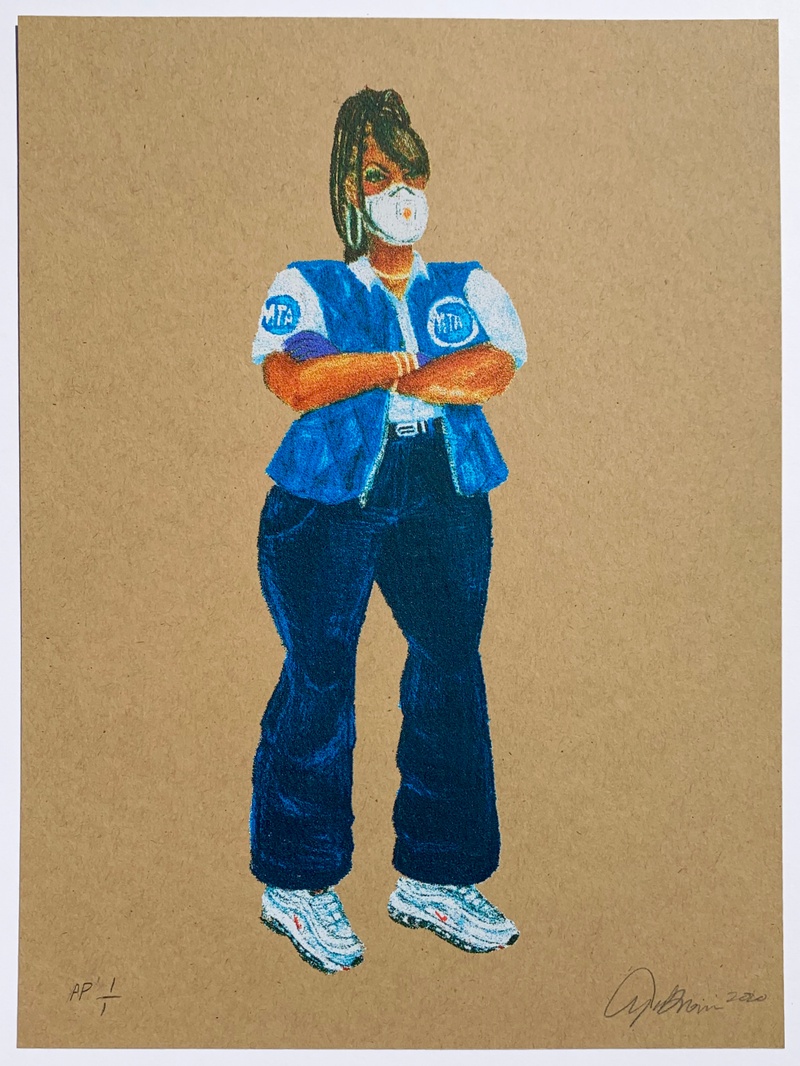
MTA WORKER, COVID-19 by Aya Brown. 9 x 12 inch 10 color screenprint on 100# Kraft Tone French Paper, published by the artist in an edition of 30. Printed by Du-Good Press, 2020.
What is the fun part of your day? What is the hard part?
The fun part is doing the actual work of the production, that’s the icing on the cake. That’s the one thing I know how to do. When I get all these really challenging jobs that are somewhat above my skill level, I have to really skill up and figure out how to do these things right. The hard part of my day is learning how to get organized enough to expand to accept all these opportunities. I can get so far with my GoFundMe, but nobody has any money to just throw on me. There are also way better causes to support. But there are these different creative ways of fundraising that have to be organized, and that’s what I’m doing right now.
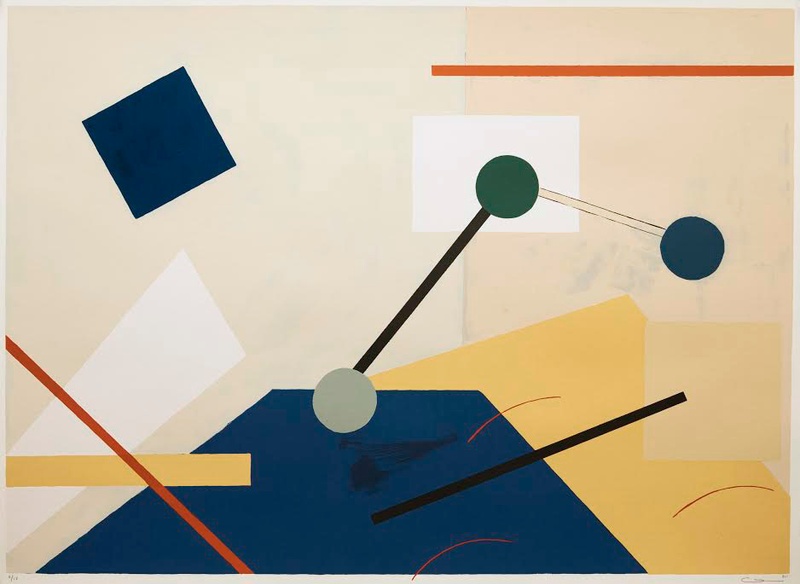
Room No.2 by Conie Vallese. 30 x 22 inch 11 color screenprint with spot varnish detail on 335gsm Coventry Rag, printed and published by Du-Good Press in an edition of 18, 2020.
There also must be a ton of organization involved in maintaining your day-to-day operations—how your space is set up, working collaboratively with artists, the many extracted layers that make up a final printed image. What helps you stay on top of everything?
Yeah, it takes a lot of ground level maintenance to be able to be so flexible to turn my living space into a print shop that’s functional. They are both messy and I can’t cross-contaminate, and I don’t want to get ink all over my bed. It takes like a level of commitment to do this to myself. You’ve got to make certain sacrifices in order to make this crazy idea viable.
I have so much energy to just make it work in the way I know I can right now. This is just a good time to experiment, and it’s low cost because my rent is under a thousand dollars. I can do whatever. I never wanted to get bigger, but I see there’s a need for me to be a representative rather than just an entity, and that I can be successful all by myself. The collaborative part of working with artists is something I just learned how to do through mostly working at [print shops]. Wearing all the hats is easy. Having extra people help me is actually harder to manage because you have to constantly be vetting them and overseeing stuff, but I’ve been doing that, too. I sometimes have assistance here and there, but it’s impossible with Covid.
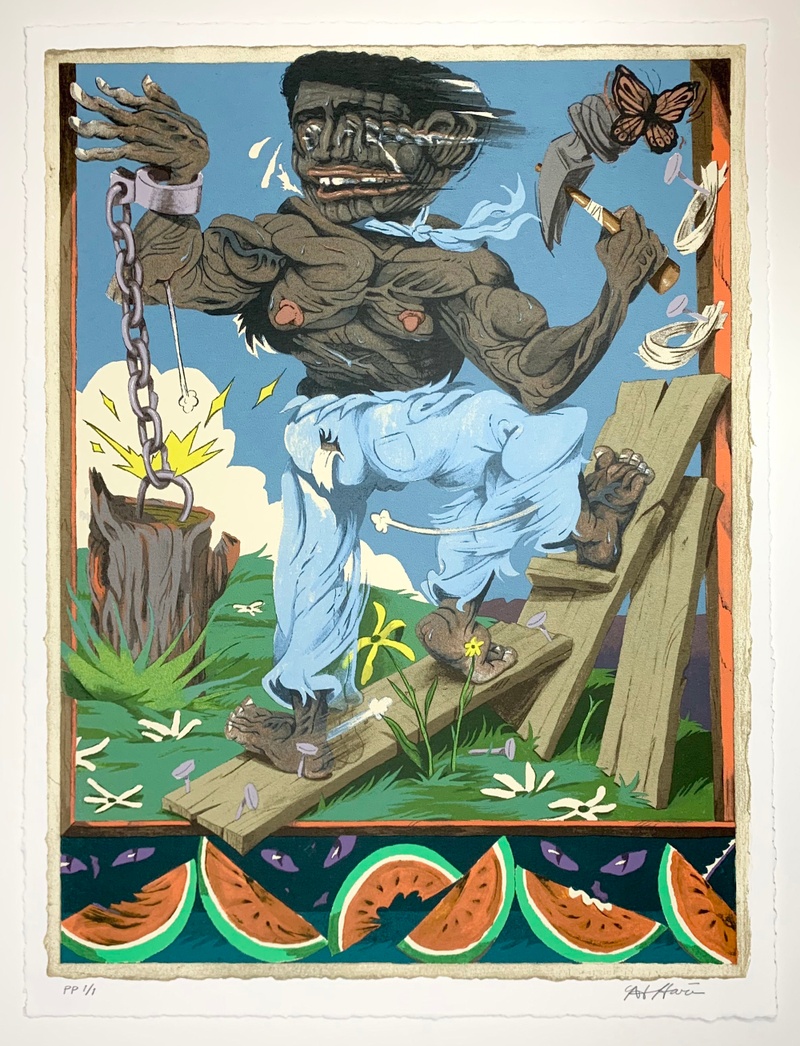
Keep it Movin by Alexander Harrison. 16.5 x 22 inch 27 color screenprint on 290 gsm Coventry Rag with a deckled edge, published by Drawer in an edition of 38, printed by Du-Good Press, 2021.
After working in other print shops, what has it been like to go out on your own?
It’s made me a lot better at being on my P’s and Q’s with the artist approvals and making sure everyone’s on the same page so that there’s a trust built into my confidence when I do have to make really fast decisions all the time on press. I feel the benefits of being fully involved now that I teach at Cooper Union, too.
What do you do when you feel overwhelmed with a project or approaching deadline?
It’s important to communicate immediately as a printmaker, because there are so many new problems that can happen if you choose to sit on something for too long. That doesn’t necessarily just work with printmaking and artists and stuff. That goes with like, “I messed up at taxes.” It’s like, “okay, don’t freak out, just get an accountant.” There are ways you can YouTube stuff to figure it out, too, but the problem-solving part of it has to be dealt with kind of quickly. I’m really good at ignoring stuff as I need to focus on printmaking especially. I force myself to focus on the task at hand by setting up an environment that’s meant for [printing]. It really helps stimulate me, to not let all of those other distractions affect the way I’m still able to produce prints. I close my door, got my music blasting. I can’t have outside influences even in my mind, you know? It’s important to be forgetful.
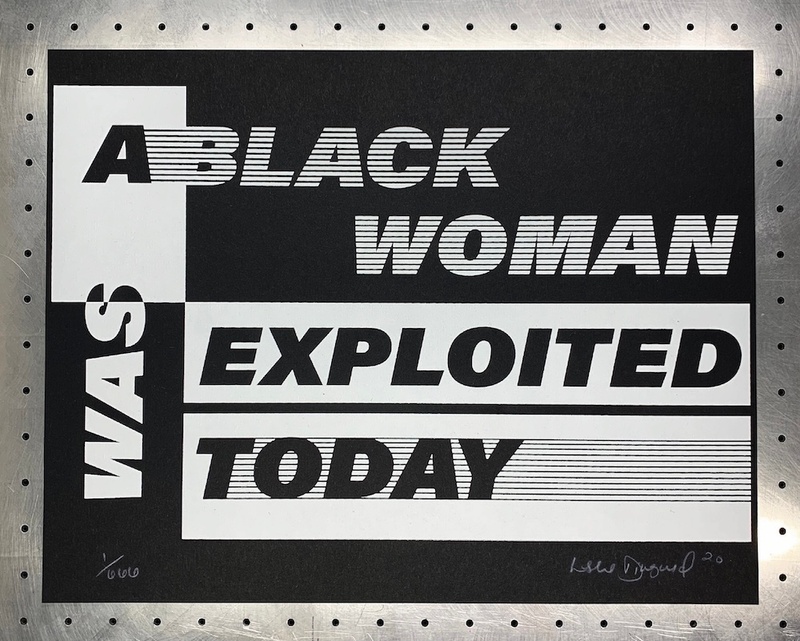
Looking Back To Find A Way Forward by Leslie Diuguid. 12 x 9 inch 1 color screenprint on 540gsm Ebony Colorplan, printed and published by Du-Good Press in an edition of 666, 2020.
How do you approach your routine, from running the business end of things to producing the artwork?
I have to be pretty flexible when it comes to maintaining balance within my own body, so I don’t fall asleep at funny times or get too wired at night. There are different ways I have to kind of turn it on and set it down real fast. Before Covid and running my own business, I was working a full-time job, sometimes two—that was a lot harder to manage than this is.
Being at home all the time is a treat, so I really enjoy being able to manage my own space and time without having to leave. In the spring of last year when this [pandemic] started, I cleaned my yard every day, and started my day [listening to] Brian Lehrer, and then talking with my group of people at work on the phone. It was a really lovely transition into working from home. I already was set up to print like this. I’ve been [making prints in my living space] for years, so only doing this [without also working other jobs]—I enjoy it so much. There’s no other better way I could be, or care to be. I enjoy it, but now my schedule has to be really maintained to not over-work myself because I also don’t see people. I’m constantly working from right when I wake up until bedtime. I really have to put my full force into making this work right and get off the ground well. There are also so many other things to manage within running my business. I can’t imagine this being functional for anyone who’s got a family to take care of, or a relationship to maintain.
I’ve short-circuited the process of working on editions, so there’s a lot of extra stuff that’s involved after and before each print is even started that can build up if you don’t have a constant cycle of assistance. Even with ink supply—even though you’re constantly working on editions, you don’t have that small time in between to kind of maintain those things. It just takes a lot of awareness of your environment, so I’m very careful on cleaning, and making sure I have enough to maintain for the future production. I can kind of do that stuff with my eyes closed because I’ve been having to do it at different jobs for so long.
Expanding is hard, but just printing is the dream. I have six roommates, so I can’t print all day long. I’m respectfully quiet until around two, three o’clock. Then I’ll start printing until midnight. But after midnight, I just shut it down and go to bed. I wake up, do e-mails and do chit-chats during the day so that by afternoon, evening, I can just do my printing routine, have some dinner, maybe leave my room. I have to really collapse all [the print set-up] to really go to bed. The way I turn off my brain from thinking about production is just to turn my lights red. That just sets me away from work, because it makes colors go away. It just makes everything red.
You screw in a red light bulb?
I’m a block away from Home Depot. Two blocks? They have these LED lights, you can make them any color, and it’s just a strip. You don’t need a lot, and you can turn it on any color, but I really like red at night. I also don’t look at my phone after a certain hour. It’s really nice to just have breaks built into my day that help with managing time. I can’t burn screens at certain times because it’s too sunny. I also can’t power wash stuff after midnight because that’s a rule I gave myself. It’s just rude. When do you stop thinking about it if you’re always in it, you know? I also only have seven screens and I’m constantly printing editions, 20 color editions sometimes, so I always have to be cleaning as I go and then recoating [the screens] every night so that by the next day I have something to print.
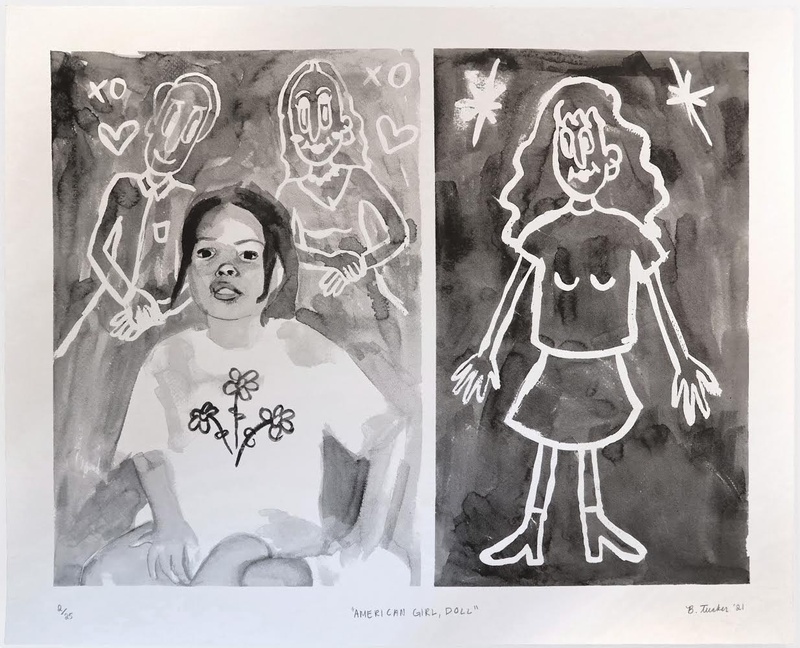
American Girl, Doll by Brittany Tucker. 16 x 20 inch 6 color screenprinted edition of 25 on 290gsm Coventry Rag, published by Du-Good Press, 2021.
What’s something you wish someone told you when you started making art?
When I started making art I wish somebody told me, “You’re going to do fine. I believe in you. You’re going to do fine.” I had a lot of nay-sayers, and I would just do it anyway, but sometimes all you need is a little encouragement. I think that goes a lot further than warning someone about the obvious problems and flaws in your plan. If you’re just fucking around and it’s an art thing, it doesn’t have to be that serious, but to give a young person permission to have their own authority can go a long way. Black kids, especially, don’t get encouraged to be artists. They’re often just told, “You’re not going to make it, even if you do get a certain degree of success.” But you know? I think that if you’re going to make art, you’re going to be fine. It’s about making art and trying. I just feel like now is the time. I’m kind of going with the flow, but there’s a lot of exciting stuff to try to keep up with, and I’ve been fighting the system my whole life. I’ve never fit into anywhere—in living places, getting jobs—it’s always been uncomfortable. So it feels normal to have to go with the flow at this point.
What would you say to someone starting something new?
Keep going. It’s one thing to try something new. It’s another thing to keep improving on that new thought. A lot of what screen printing is is just refining your form. You have a matrix that you’re working off of, and even that is taken from a bigger picture. You’re using those small elements, looking at one layer at a time to kind of make improvements on that individual artwork. That’s what I’m doing. If you’re the one making the artwork and playing with a new idea, it just takes a lot of tinkering in order to get good at it. It’s important to tinker, but you’ve got to stick with any one thing in order to make advances in that area to your advantage. It’s not like, “I’m going to do this and change the world.” It’s like, “Fuck that. Just do what you can do.” If you try, that’s a thing you learned. If you did it well or not, you still did something.
- Name
- Leslie Diuguid
- Vocation
- Artist, fine art printer, founder of Du-Good Press
Some Things
Pagination



